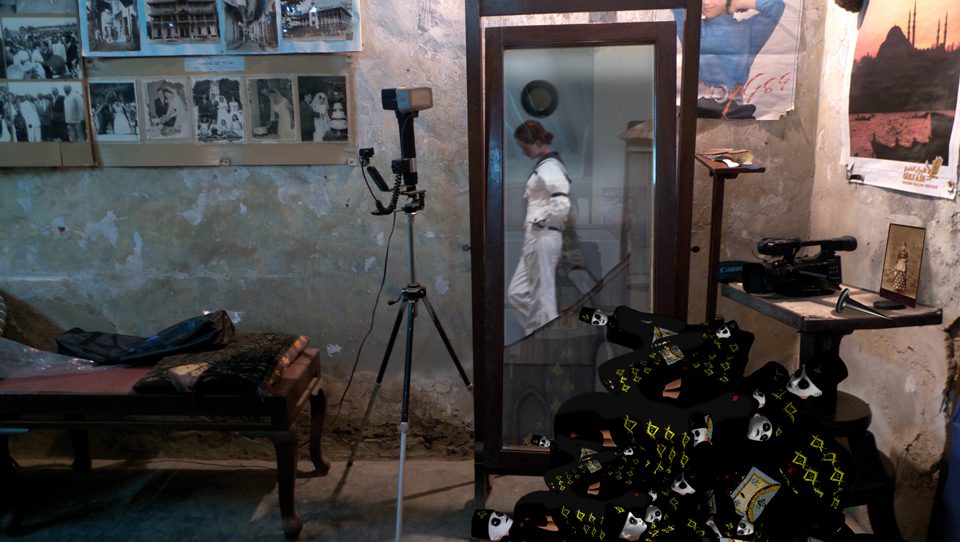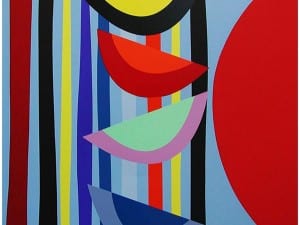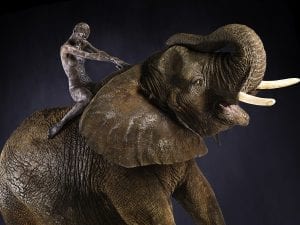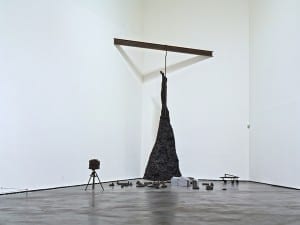A new group exhibition at the Hayward Gallery explores the dilemmas, consequences and realities of London in the digital age through a staggering array of multi-disciplinary works.
J.G. Ballard was an English writer associated with new wave science fiction, although he, himself, despised the term and preferred to categorise his work as “apocalyptic.” Behind Ballard’s bohemian appearance was an obsession with psychosis, assassination and violence, and a complex past in part explained by his novel Empire of the Sun (1984), which was adapted for the screen by Steven Spielberg. Ballard was born in Shanghai, and following the Japanese seizure of the city was interned in Lunghua Camp with his family as a young boy. Moving from a “cruel city” to a camp where food supplies were so low that he and his fellow inmates resorted to eating weevils for protein, Ballard had an understanding of dystopia even before reaching adulthood. Returning to England in 1946, Ballard spent brief stints at medical school and in the RAF, before publishing his first novel in 1961, The Drowned World, in which he argued, quite rightly, that global warming could ultimately cause the flooding a number of the world’s major cities.
Ballard’s work is so distinct that his name has given rise to the adjective Ballardian, which references “dystopian modernity, bleak man-made landscapes and the psychological effects of technological, social or environmental developments.” Amongst many of the films, books and artworks emerging in our current climate, there is a strong Ballardian theme – something which chief curator Stephanie Rosenthal has tapped into when planning the Hayward Gallery’s autumn 2014 exhibition, later given the title Mirrorcity.
Rather than exhibit artworks that study the past or imagine the future, Rosenthal made the initial decision to create an exhibition that allows viewers to “just be aware of where we are now.” To do this, she spent 2013 visiting over 100 studios across London – a part of the world that she outlines as “a point of artistic culmination” – to source the final 23 exhibiting artists. After speaking to just 60 people, Rosenthal discovered that Ballard was cited as an influence by almost everyone – less for his bleak world view, but more his convention of building an imaginary utopian world in the minds of his characters, their past or future, which interrupts the physical world.
She explains that this idea has such a vivid relevance for artists working in London, a capital of finance and “point of culmination” to Rosenthal, as the population of contemporary cities are always connected via screens and the internet both to a “virtual utopian world and the existing rational world.” This modern condition, where the virtual and physical exist simultaneously and yet are at odds, was of particular significance to Rosenthal, who believed it crucial that the work explore “the now.” Therefore, the exhibition reflects the dynamism and “copy and paste aspect” of London: dramatic steel constructions stand alongside delicate canvas pieces, just like the silver skyscrapers and sandstone buildings which make up The City.
Mirrorcity is a combination of recent pieces and site-specific commissions produced by both emerging and established artists, all of whom examine the way in which the digital and the physical space now cross over and fold into one another. While the artworks themselves range from film to installation, performance to sculpture, and painting to text pieces, all ask similar questions: what is the effect of advanced technologies on our lives? How do we navigate between the virtual and physical worlds? How do we experience reality? And what are the conditions of our existence today?
The 23 exhibiting artists are Turner Prize winner Laure Prouvost; Mohammed Qasim Ashfaq; Susan Hiller; Michael Dean; Tim Etchells; Anne Hardy; Helen Marten; Ursula Mayer; Emma McNally; Karen Mirza and Brad Butler; Katrina Palmer; Aura Satz; Lindsay Seers; Tai Shani; Daniel Sinsel; John Stezaker; Lynette Yiadom-Boakye and collectives Lloyd Corporation; Pil and Galia Kollectiv; LuckyPDF and Volumes Project (Frank Bock, Nicola Conibere and Martin Hargreaves). The broad range of creative contributors mirror Rosenthal’s fairly open brief: artists who address and explore the implications of the conditions existing right now, whose work is not intended to be visionary or futuristic. The curator explains that she “wanted artists from all generations and all media” and that although each work should deal with “the challenges of the digital age”, they “don’t have to be forcibly expressed in a digital way.” Therefore alongside a heavy use of film, which Rosenthal highlights as “a good medium to cross the border between fiction, fact and documentary” there is a great deal of performance – be this in the form of single musical events or ongoing actions – and analogue media as well.
Some works are less overt in their examination of our current climate; Lindsay Seers’s (b. 1966) immersive installation Nowhere Less Now 4 (2014), for example – an upturned ship which houses a film, and which was originally conceived for The Tin Tabernacle 19th century chapel in Kilburn. Although inspired by a photograph of her great, great-uncle who was a sailor, and therefore autobiographical, the piece creates a new, imagined actuality based upon memory and henceforth studies the space between reality and fiction. As Rosenthal asserts: “Seers’s interest is mainly in blurring the boundaries between fact and fiction, and from her perspective there is no difference between the two; it’s all part of what we experience as our reality.”
Meanwhile John Stezaker (b. 1949) presents collaged analogue photographs and hand-printed silk screens, many of which are new for Mirrorcity, and which at first glance are dissimilar from the majority of the exhibition. However, Stezaker is, in fact, an inspiration for many of the exhibitors; like Ballard, the English conceptual artist spent the 1970s and 1980s looking forward to what is our current “now” and made work which almost prepared generations to come for the issues which he expected them to have to deal with in the future. Stezaker is described by Rosenthal as something of a trailblazer in thinking about “what it means to overlay different stories and realities” and he is an artist whose work, new and old, is consistently relevant to the conditions of our current digital age.
Not surprising for an exhibition that discusses our various ways of “being”, several people in addition to Seers have constructed life-sized, experiential installations. Anne Hardy (b. 1970) brings Two Joined Fields (2013), which for the first time allows viewers to physically enter the intricate sculptural installations that she usually captures only in photographs; and Susan Hiller (b. 1940) presents a new film Resounding (Infrared) (2014) which is an assault on the senses, combining sound frequencies and visual patterns that have been translated from radio waves originally emitted by the Big Bang. Displayed as a large installation, this 30-minute piece is also accompanied by a series of eye-witness accounts of extra-terrestrial phenomena and experiences and therefore conjures up an eerie yet hypnotic world filled with magic and possibility.
Meanwhile, the 29th Turner Prize winner Laure Prouvost (b. 1978) presents The Artist (2010), which invites the viewer into an information overload: a chaotic rendering of her studio which, itself, is depicted in the film show inside. French artist Prouvost is of course best known for her 2013 Turner Prize-winning video, Wantee, which offers a witty tribute to a fictional grandfather. The name, Wantee, was the nickname given by European Modernist Kurt Schwitters to his partner, who liked to offer him frequent tea and so was displayed as part of Tate Britain’s Schwitters in Britain exhibition in 2013. Shown inside an immersive installation of her grandfather’s dated house, the set up can be seen as paving the way for Prouvost’s The Artist – which, like much of her work, features her fictional grandfather once again.
Another notable artist of the pick is Helen Marten (b. 1985), a young experimental sculptor who presents hyperreal sculptures to test the boundaries between nature and commodity; she explains “we are generally obsessed with the ‘skins’ of objects” without unpacking what they actually mean to us. Although her work has been known to combine frivolous items such as doughnuts, empty bottles, pyjamas and fruit stickers, the themes she works with are in fact deeply considered: addressing our consumption of images, and our underlying reasons for attaching value to them.
The works presented here from emerging artists are equally experimental: Volumes Project, for example, with their performance art that sees one artist running around the Hayward in a circle before suddenly exiting. This is a commissioned work, conducted by a choreographer, theorist and artist, and whose brief, according to the curator, was “to show how one can transform that idea of crossing [the virtual and physical worlds] or living between these spaces.” Collaboration within Mirrorcity is key to this exhibition: between the artists, the works, and between the works and the space they are housed in, as many new commissions have been created less for the sake of making a new artwork than of building an exhibition which works cohesively within the Hayward – something of a maze of rooms across several levels.
This is somewhat appropriate for an exhibition which strives to reflect our experience of the contemporary metropolis, and whose name derives from Michel Foucault’s essay Of Other Spaces (1967). Foucault discusses utopia and heterotopia, the former being an ideal state and the latter being “places that do exist and that are formed in the very founding of society.” He goes on to state that “between utopias and these quite other sites, these heterotopias, there might be a sort of mixed, joint experience, which would be the mirror.”
As Rosenthal argues, we now constantly live in this mirror: London is a “mirror city” in that its inhabitants are always surrounded by heterotopias and utopias, and their reality is somewhere in between the two. She explains: “At times we are living in a new space, this mirror that Foucault describes as a thin thing that we see ourselves in but don’t live in. My idea for the show and the works is that we now live our lives between – the virtual and physical world.”
She continues: “Nowadays we are constantly connected to the internet, so we are aware of what’s going on all over the world and linked to it through social media; we are very nearly occupying a new type of reality.” The works speak about this new condition, this new method of living between the physical world and the virtual and digital space.
Mirrorcity is, thankfully, not simply Ballardian in tone, although the influence of new-wave science fiction is tangible in its examination of confused realities, hyper-reality, high-tech and low-tech operations. Rather, the works embrace the urgency and the multi-layered state of contemporary London, whereby individual experience becomes only a small part of a living metropolis. To continue this otherworldly experience, author Tom McCarthy (b. 1969) has conceived an “alternative” newspaper especially for Mirrorcity that includes a diverse and distinctive array of texts and pictures which have been provided by the exhibiting artists, providing this startling and comprehensive reconstruction of the “now” with a past and a future.
Mirrorcity is one of three exhibitions which will run in the lead-up to the two-year closing of the Hayward Gallery, during which time it will be fully refurbished. Following Mirrorcity will be the first ever UK retrospective of Belgian artist Carsten Höller, taking place during summer 2015, and a group exhibition involving six individual artists. For this final exhibition, Richard Wentworth, John Akomfrah, Jane and Louise Wilson, Hannah Starkey, Roger Hiorns and Simon Fujiwara will each curate a “chapter,” using objects, artefacts and artworks that they feel reflect an important moment in history since 1945. The issues explored will range from the emergence of key social institutions and consumerism to mad cow disease and the origins of the surveillance state – looking back at the causes and catalysts of British politics, psychology and sociology as it is today, and which underlie contemporary British art as it is represented in Mirrorcity.
Mirrorcity runs at the Hayward Gallery, London, 14 October – 4 January. Further information can be found online at www.southbankcentre.co.uk.
Chloe Hodge





